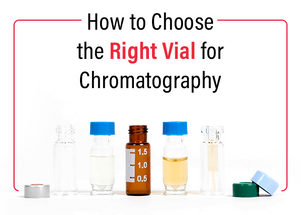Posted by Chrom Tech on 6th Nov 2025
How To Choose the Right Vial for Chromatography
Most modern liquid chromatography autosamplers are designed to hold 12 x 32 mm vials, making them the standard for HPLC and LCMS analysis. (Note: Headspace autosamplers generally use 20 mm wide vials.) Choosing the right vial involves understanding closure type, volume, material, and color—each of which can affect sample integrity and analytical performance. Below is a step-by-step guide to help you select the best vial for your chromatography application.
Step 1: Determine Vial Closure Style
Choosing the correct closure is crucial for ensuring a proper seal and preventing sample loss or contamination. Chrom Tech offers several closure styles, each designed for specific chromatography workflows.
- Screw Thread Vials: Commonly used in HPLC and LCMS applications, screw thread vials are convenient because they do not require tools for tightening or removal. They’re ideal for repeated access to standards or samples.
- Crimp Vials: Preferred in gas chromatography (GC) where sample evaporation and tamper resistance are key concerns. Crimp vials provide a secure, leak-free seal and are essential for chain-of-custody applications. We recommend using an electronic vial crimper for ergonomic and consistent sealing.
- Snap Top Vials: Snap-top vials offer quick sealing and removal without tools, making them a convenient alternative for HPLC and LCMS users who prioritize speed and simplicity.

Why Choose Screw Thread Autosampler Vials?
Screw thread vials are favored for their ease of use and reusability. They eliminate the need for crimping tools and are perfect for analytical standards that require multiple openings. These vials are the go-to choice for HPLC and LCMS analysis and general sample storage.
Step 2: Determine Vial Volume
The standard autosampler vial holds 2 mL and is compatible with most chromatography systems. However, the appropriate volume depends on your sample size and analytical needs.
- Vial Inserts: If you have a limited sample volume, pair your 2 mL vial with an insert. Tapered inserts (up to 250 μL) allow maximum recovery, while flat-bottom inserts (up to 400 μL) offer a more economical solution.
- High-Recovery Vials: For applications requiring multiple injections or low sample waste, high-recovery vials ensure maximum retrieval from minimal sample volumes. Chrom Tech’s high-recovery vials are fully compatible with Waters HPLC autosamplers.


Step 3: Choose the Right Vial Material
Vial material impacts sample stability, reactivity, and compatibility with solvents.
- Glass Autosampler Vials: Type I borosilicate glass is the most common choice for HPLC and GC. It offers low reactivity and minimal pH shift, ensuring consistent analytical performance. Type I clear glass has a coefficient of expansion of 33, while amber glass has 51 for enhanced chemical resistance.
- Plastic Autosampler Vials: Made from polypropylene (PP), these vials provide an economical and shatter-resistant alternative. PP vials are compatible with acetone, methanol, ethyl acetate, and isobutyl alcohol, but not with chlorinated or aromatic solvents like toluene and dichlorobenzene.
Other Plastic Options:
- Polyethylene (PE): Ideal for acids, alcohols, and bases; not compatible with aromatic solvents or acetic anhydride.
- TPX (Polymethylpentene): A transparent, lightweight polymer that offers superior heat and chemical resistance—useful for specialized applications.
Step 4: Determine Clear or Amber Vial
Clear glass vials are standard for most chromatography applications, but amber glass vials or black polypropylene vials should be used for light-sensitive compounds to prevent degradation.

Conclusion
Choosing the correct autosampler vial can directly impact the accuracy and longevity of your chromatography system. Chrom Tech offers a wide selection of chromatography vials, inserts, and closures—along with competitive pricing and fast shipping. Whether you’re performing HPLC, GC, or LCMS, our Chrom Tech Vial Experts can help you find the best solution for your workflow.
Ready to explore all vial types? Visit our Chromatography Vials resource center to compare HPLC, GC, and headspace options in one place.
Frequently Asked Questions About Chromatography Vials
What is the most common autosampler vial size?
Most chromatography autosamplers use 12 x 32 mm, 2 mL vials. These are compatible with the majority of HPLC and LCMS instruments.
When should I use amber vials instead of clear ones?
Amber or black vials should be used when working with light-sensitive samples to prevent photodegradation and maintain sample stability.
Are plastic vials suitable for all solvents?
No. Polypropylene vials are compatible with most polar solvents but not with aromatic or chlorinated solvents. Always verify solvent compatibility before use.
What is the benefit of high-recovery vials?
High-recovery vials minimize residual sample loss, allowing multiple injections from small-volume samples—ideal for high-value or limited samples.

